Lost Opportunities at Dogger Banks, or Battle Battle Cruisers and Intelligence
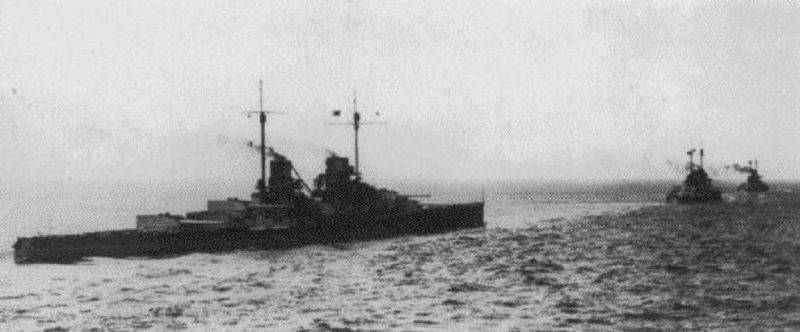
The British public furiously frantically, like a teapot, forgotten on a spirit-lamp by a sleeping porter. Hyde Park, this corner of public speaking, buzzed unkindly. Solid and not very gentlemen (the burden of military service has not yet touched England), shaking their fists, canes and other improvised objects, drilled the air and minds of the listeners with righteous anger, unjust abuse and concentrated bile. No wonder ... Unheard of shame and humiliation - these Teutonic Huns, bloodthirsty destroyers dared to bombard the sacred shores of Albion from their ships. From the time of the cunning Dutchman de Ruyter, England did not know such humiliation and shame. "Robber and the infanticide Hipper!" How long ?! ”- the speakers were indignant. “How long ?!” echoed the press. “How long ?!” - the lords in parliament asked. Admiralty was something to think about.
German Fox in English Coop
The outbreak of world war was finally to dot the i's naval rivalry between England and Germany. Whose ships are better, whose admirals are more aggressive, intelligent and talented? This could only be solved by experience, that is, by battle. And here inexorably interfered another factor that influenced all the previous ones: who has more ships. This advantage traditionally remained with the islanders. The frost breeze of doubt, which arose in the study of reference books of the ship staff and comparative tables of combat-ready units in service, cooled the hottest heads. In the mess-rooms of the German battleships, they continued to drink for Der Tag, which was constantly postponed. The British, despite their militant readiness to show who is the master of the ocean, were also in no hurry to wave the Nelson boarding saber. The German fleet was a real force, the like of which the British did not encounter Napoleonic times. Both opponents were waiting for the opponent to be the first to make a mistake and put himself under attack.
Kaiser Wilhelm, sincerely loving ships and everything connected with them, understood little in the intricacies of naval strategy. German divisions in the early months of the war briskly advanced, and, it would seem, the capture of Paris was a matter of the near future. The high seas fleet did not leave the Helgoland Bay - it was decided not to expose it to deliberate risk, but for now, emphasis should be placed on equalizing forces with an intense mine war and the use of submarines. The British also had something to think about. Already on August 9, the light cruiser Birmingham rammed the U-15 submarine in the North Sea. This event, seemingly successful for the British, influenced the thinking of the British admirals, showing that for German submarines it was not at all a problem to be in relative proximity to the English bases fleet.
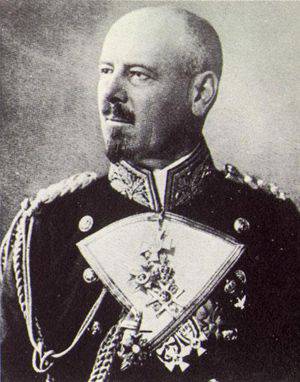
Fighting on land made its own adjustments to the course of the struggle at sea. 16 October 1914 was seized by the port of Zeebrugge by German troops. The fleet command decided immediately to use this success for their own purposes. This gave impetus to the whole set of events that eventually led to the Battle of Dogger Banks. Already on October 17, four German destroyers left Ems for a mine setting at the mouth of the Thames. If necessary, they could use Zeebrugge as a base. British intelligence was not asleep, and a detachment of light forces consisting of one cruiser and four destroyers was sent for interception. In the fleeting battle all the German ships were sunk. Admiral Ingenol, commander of the open-sea fleet, considered himself entitled to demand revenge for such a slap in the face. But in the matter of revenge, it was necessary to remain cautious - the concept of “equalizing forces” was still far from complete. Therefore, it was decided to intensify mine settings, and to divert attention, to risk and bombard the coast of England. In addition to light ships, the 1-I reconnaissance group of Rear Admiral Franz Hipper was involved in the operation, the battle cruisers - the combat vanguard of the High Sea Fleet. The result of the operation undertaken on 2 – 4 in November was the shelling of Yarmouth, media hype and fuss in the Admiralty. In the end, it turned out that to catch a gang, so brazenly and unceremoniously crept to the shores of England, is very difficult. The main forces of the fleet, fearing the submarines and other tricks from the Germans, were based north of Scapa Flow, and could not immediately advance to the scene. To prevent such raids, the Admiralty relocated its high-speed guards, Admiral Beatty battlecruisers, and south to Cromartie. In addition to them, 3-I battleships were deployed to Rosyth. Armadillos of the type "King Edward VII" that entered into it looked, of course, solidly, but for the effective interception of Hipper high-speed ships they clearly lacked glibness. Finally, in order to mislead the enemy, the 14 of the old ships disguised as the dreadnoughts of the Grand Fleet and hid in plain sight. It is not known whether this ploy acted on enemy reconnaissance or not, but the raids of the 1 reconnaissance group continued.
The Germans paid their next visit to 16 December. It was decided to fire on the coast of Yorkshire, incidentally putting minefields in the area. Hipper insured almost the entire fleet of the open sea. It should be noted that the British had one very solid trump card up their sleeve, which they successfully used for a long time. The fact is that the 27 of August 1914 of the year sat firmly on the stones in the Gulf of Finland and the German light cruiser Magdeburg was captured. Together with him were captured encryption books of the German fleet. Russian sailors generously shared with their English allies, and soon a special institution in the Admiralty, known as the “40 room,” could decipher the enemy messages. About the exit of the Hipper cruisers, British experts reported on time, but made a mistake with the main forces of the Germans, for some reason deciding that they would not go to sea. To intercept the German battlecruisers, in addition to the already-mentioned Beatty ships, the 2-I division of the battleships of Vice-Admiral Worender was allocated - six dreadnoughts and light forces.
In the analysis of the events that happened afterwards, both sides were in agreement. Admiral Tirpitz, the sword of thunder and lightning, exclaimed that "Ingenol was holding the fate of Germany in his hands." He was echoed by Winston Churchill's poisonous hiss about losing the possibility of taking a great prize - the German battle cruisers. The first, and perhaps the last time in the entire war, the Germans had the opportunity to attack only part of the Grand Fleet (six battleships and six battlecruisers) with all their forces. But this did not happen - in conditions of poor visibility, both connections diverged literally 10 miles from each other. Hipper, having fired at Scarborough, Whitby and Hartpool, and having himself suffered from the coastal batteries of the latter, already twisted between the English squadrons and minefields and was like that.
In addition to the resonance caused in military circles, the public, having read the eloquent British press, gave vent to the feelings. During the shelling of Hartpool, 86 people died, among them 15 children. More than 400 people were injured. Hipper cruisers branded as child-killers and did not part with this stamp until the end of the war. A wave of indignation, directed in the right direction by the propaganda machine that was gaining momentum, swept through England. The commoners and members of Parliament asked the same question: what is the structure that the full-blooded pound rivers are going to undertake? Cheerful and evil old men with Victorian sideburns, shaking heavy canes, commemorated Nelson and other horrors turning over in his coffin. From high orbits, not excluding the courtiers, signals were sent to the Admiralty, easily deciphered as “Do something!” The Admiralty swore - and did.
Raid, turned into a race
First, shortly before Christmas 1914, the Beatty cruisers were moved further south - now to Rosyth. Secondly, the number of light ships involved in patrolling the North Sea has been increased. Third, reconnaissance measures were strengthened - the “40 room” poured over German texts day and night. The opposite side was also not against a run to the enemy shore. And the incentive for this was. 25 December 1914 of the year British seaplanes with Engandine, Riviera and Empress under the cover of destroyers and light cruisers carried out the first stories airstrike on the German airship base at Nordholz. This action had no practical effect, with the exception of the loss of three aircraft and a powerful propaganda resonance. Now it was the turn of the Berlin offices to withstand the fierce rattling of Prussian spurs.
The desire of both sides to punish each other was so great that the inevitable collision became a matter of a very short time. The German command has long had information that in the Dogger-banks area, English trawlers and other trifles are constantly hanging around, which, according to German intelligence, was engaged in the systematic transfer of information to the island. In order to strike at the English patrols, the commander of the 1 th reconnaissance group of the High Sea Fleet Franz Hipper was ordered to go to sea. 23 January 1915, the ships of Hipper - the permanent "Seidlitz" (flagship), "Moltke", "Deflinger" and "Blucher" - left the base. Von der Tann was under repair and did not participate in the march. They were given the 2-I reconnaissance group, consisting of light cruisers Graudenits, Stralsund, Kohlberg, Rostock and 18 destroyers.
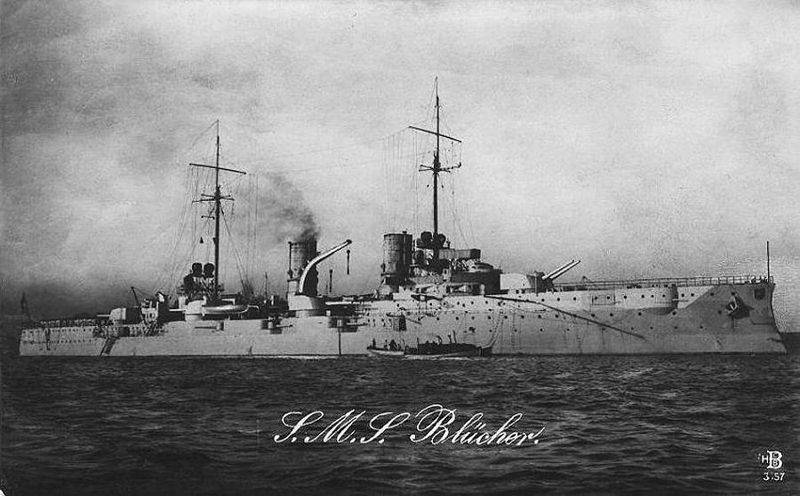
A few words should be said about "Blucher". This ship, built as a reduced copy of the first Germanic Dreadnoughts of the Nassau type, was not a full-fledged battle cruiser, but rather was brought to perfection by armored. Its main caliber, consisting of twelve 210-mm guns, ensured Blucher an advantageous position in a duel with any peer of the Russo-Japanese war, but for the battle with Beatty's squadron ships, despite the excellent booking, he was clearly weak. Nevertheless, as the most advanced in characteristics of all the armored cruisers of Germany, the "Blucher" was part of a compound consisting of linear cruisers.
The “40 room” didn’t sleep, and the news of the “Hipper gang’s release” quickly spread to interested military instances. And those interested, given the raging office passions, were in abundance. At a very rapid pace, all the cruising forces of Admiral Beatty sailed into the sea - now they were already reduced to two squadrons. The first consisted of the Lion, Tiger, and Princess Royal battlecruisers. The second, commanded by Rear Admiral Moore, included New Zealand and Indomiteble. The Beatty ships were accompanied by light cruisers Commodore Gudenaf in the amount of four units. To these forces was to join the squadron from Harwich, and these are four light cruisers and 34 destroyer. A meeting point was scheduled for January morning 24 in 30 miles north of Dogger Banks. Naturally, this is not limited. 3-I squadron of old battleships such as "King Edward VII" had to leave Rosaita and provide security for the east coast. Finally, on the evening of January 23, a long armored anaconda from Scapa Flow crawled out to the main fleet forces, accompanied by three squadrons of cruisers and a large pack of destroyers.
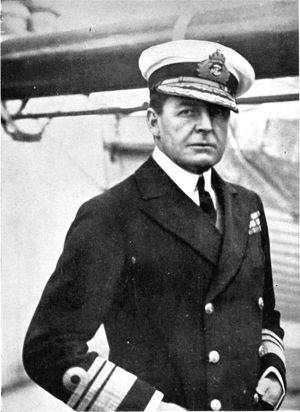
There was no guarantee that Ingenol would not try his luck by covering Hipper’s back either. The German compound was confidently moving towards Dogger Bank, not even knowing about the British preparations. Between 6 and 7 in the morning hours of January 24, Admiral Beatty gathered his fist forces and intended to deploy the forward patrol line to the north. However, the events that have begun have prevented this from happening. In the 7 hours of the 10 minutes, the light cruiser Aurora from the Harwich squad spotted unknown ships in the fog, which they initially took for their own. It was none other than the cruiser "Kolberg", performing the functions of intelligence from Hipper. "40 room" fully justified the expectations placed on it: the data obtained allowed us to finally intercept the much-desired adversary.
The Kohlberg opened fire with the 40 cable and was able to get into the Aurora three times, however, this did not harm the English ship. On the contrary, the successful hit of the English projectile under the bridge of the German cruiser made him swiftly turn east. Hipper began a rapprochement with the "Kohlberg" - at first, the rear admiral thought that there was a clash with one of the patrol cruisers covering the scout trawlers. However, a new and very disturbing discovery made it possible to quickly change plans - new and numerous smokes of enemy ships became visible to the North-West. Believing that he was dealing with a squadron of battleships, Hipper turned to the south-east and began to withdraw. Meeting with such opponents in the plans of the Germans was not included. After receiving the radio from Aurora, Beatty ordered the persecution to begin immediately. The enemy was discovered, and now it remained only to correctly drive him into a corner.
Light cruisers were instructed to keep German ships within sight, while Beatty’s main forces were catching up with the enemy. The Germans were able to finally figure out who they were dealing with, in 8 hours 40 minutes, when the distance between squadrons was reduced to 14 miles, and it was already obvious that the battle could not be avoided. Wanting to quickly catch up with the enemy, the British constantly increased speed: in the 8 hours of the 23 minute, the order was given to have 26 nodes, then 27. In 8.54, Beatty called the number of 29 nodes — the speed limit that his battlecruisers could count on. Rear Admiral Moore’s older ships began to fall behind — New Zealand and Indomiteble could develop a maximum of 27 nodes. Beatty deliberately took such a risk - he wanted at any price to overtake the enemy. The British battlecruisers were rebuilt with a bearing so that they could be able to put in feed towers. The distance was slowly but steadily decreasing, and in 9 hours the flagship Lion launched the first salvo from the 10 cable course to the end ship in a German column. That was Blucher, the weakest link in the Hipper team.
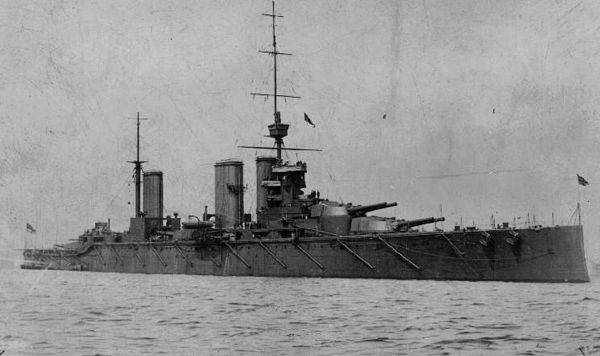
Soon, Tiger and Princess Royal joined the flagship of Vice Admiral Beatty. Already after 15 minutes "Blucher" received the first hit. At 9 hours 14 minutes the Germans fired back. Lion moved the fire to the Deflinger, and two Englishmen continued to process the Blucher. The third British salvo brought a hole near the waterline, and the cruiser’s speed dropped. The fourth destroyed the feed settings. But the most painful hit was caused by a shell that pierced the armor deck and exploded in the corridor of the supply of ammunition in the nose side towers. The flames escaping from the elevators, overwhelmed their offices and incapacitated. The loss in the crew was very sensitive. The Germans also shot, and in 9 hours 28 minutes, a shell struck the waterline "Lion" and exploded in a coal pit. By this time, puffed up, out of breath, "New Zealand" and opened fire on the "Blucher" - he was the first to be within his reach.
In 9 h. 36 min. Beatty ordered his ships to distribute targets. Flagship "Lion" was supposed to shoot at "Zeidlitz", "Tiger" - at "Moltke", "Princess Royal" took over "Deflinger". Lagging behind newer colleagues, “New Zealand” and “Indomiteble” were assigned the task of finishing “Blucher”. However, the Tiger commander, captain 1 of rank G. B. Pelli, misinterpreted the order of his admiral and for some reason decided to also focus the fire on the German flagship, since the British had five ships in a convoy, unlike the four German ones. As a result of this blunder, the German Moltke didn’t touch 15 minutes at all. There was no practical benefit from firing on the “Seydlitz” - the calibers of both British ships were the same, and the gunners on the “Tiger” confused their gaps and flagships. Nevertheless, in the 9 hours of the 43 minute “Lion” achieved a hit in the “Seydlitz”, which influenced the outcome of the battle. The shell struck the barbet of the aft tower, causing the charges to ignite. The fire destroyed the calculations of both the main caliber stern towers. The quick actions of the senior officer of the German flagship who flooded both cellars prevented perhaps even more serious consequences. “Seydlitz” was damaged - he took more than 1 thousand tons of water and donkey astern. Hipper, considering the situation to be critical, immediately sent a request for help to Ingenol. However, 150 was still miles to shore, and the German Dreadnoughts could appear at best only in a few hours.
The English ships, remaining unharmed for some time, also began to receive damage. First, the hit of the projectile on the Lyona jammed the tower A, however, it was quickly repaired. And at the start of the 11, this battlecruiser suffered more serious damage - two 280-mm projectiles from the Seidlitz simultaneously hit it. One damaged the left-side nutrient tank, which immediately affected the speed of the car. In addition, the water got into the premises of switchboards and caused the closure of two dynamos. In addition to this, firing fire control devices were disabled. "Lion" began to roll to the left side, its excellent speed so far has dropped to 24 nodes. Despite the damage he sustained, Beatty continued to draw closer, and then his flagship befell new disasters in the form of two more hits. There was a hole below the waterline, the water entered the nasal coal pits, the second projectile landed in the nose. The hits in Lyon became more frequent - there was even a fire in tower A, but it was quickly managed to be localized.
The position of the German squadron was more serious. On the "Blucher" fires were raging with might and main, its speed began to gradually decrease and fell to 17 nodes. "Seidlits" heavily dragged the damaged stern, the consumption of ammunition main caliber on it was just huge. It seemed that in the battle, finally, a turning point came - “Blucher” lost control and began to roll out to the left. Although the Lyon itself could no longer keep the calculated speed, other squadron ships remained operational and could smash the enemy with their heavier guns (343 – 305 versus 280-mm from the Germans). However, now the scales of military happiness were shaken and swung slightly toward Hipper. The flagship Beatty in the gap between 10.49 and 10.51 again received at least four "greetings" from the Germans who had been shot at: the last dynamo was put out of operation, the battle cruiser was practically de-energized, lost all means of communication, except the flag. Roll reached 10 degrees.
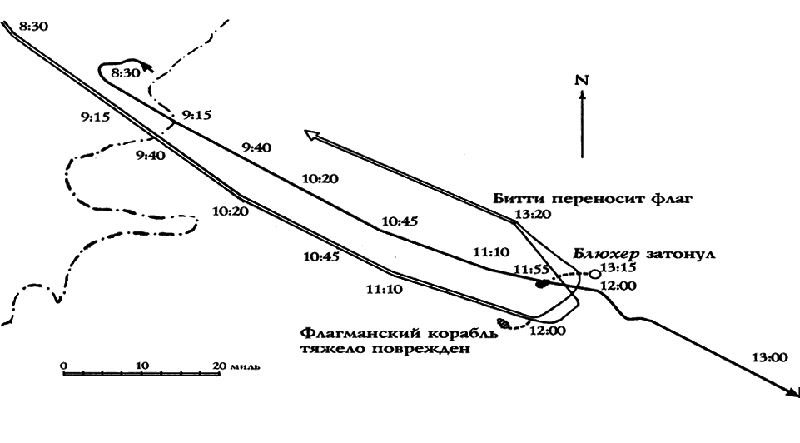
And here in the 11 watch area, observers on the Lion bridge suddenly thought that a submarine was nearby. Beatty, obviously remembering the fate of Abukira, Kresi and Hoga, ordered to immediately turn “all at once” on the 8 points to the left. However, realizing that this maneuver only increases the distance with the enemy, the British admiral already in 11.02 gives the order to raise the flag signal "course NO", in order to limit the rotation of the 4 points. Immediately on the falons of "Lion", a new instruction is thrown up by his subordinates: "Attack the tail of the enemy's column." Not satisfied with this, the English flagship signals: "Stay closer to the enemy." Further events have several interpretations. You can stay on the more common.
Since the nervous Beatty raised the signal after the signal, a certain confusion arose on the masts of the Lion left without radio communication. The command “Keep Closer to the Enemy” was raised when the previous signal, that is, the “NO course”, was fluttering on the heads. From the rest of the squadron ships, this was all interpreted as one: “Attacking the enemy’s tail in the northeast.” In the northeast was at this time heavily damaged "Blucher." The extreme Beatty signal, in the opinion of other English officers, was not read due to smoke. In any case, none of the battlecruisers reacted to it. Junior flagship Rear Admiral Moore could, of course, think over the brain, take the initiative and rush in pursuit of the departing Hipper. However, between the most likely "Victoria Cross" and a no less likely challenge to the carpet, the disciplined Moore chose a third way: without taking the initiative, to follow the letter of the order - and pounced on the agonizing "Blucher". On the other hand, Beatty himself provoked his younger flagship, because the order “Attacking the tail of the enemy's column” could be interpreted in two ways.
Seeing that his battlecruisers did not fulfill the necessary orders, in 11 hours in 50 XNUMX passed on to the destroyer Ettek and rushed to catch up with the squadron ahead. Hipper, with relief noticed the rather strange maneuvers of the British, who, having stopped the pursuit, suddenly turned away, made the only right decision: having sacrificed "Blucher", to retreat to the base. By this time, only Moltke and Deflinger retained relative combat capability.
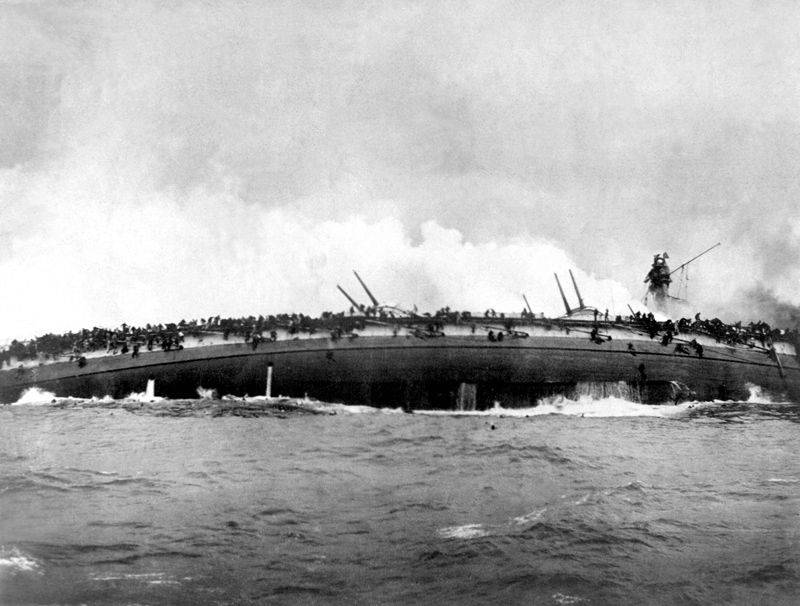
Meanwhile, the entire British squadron was engaged in the execution of the doomed "Blucher". The German ship, according to the English themselves, was a "terrible sight." Nevertheless, his guns continued to respond. When the destroyer "Meteor" approached him for a torpedo attack, a heavy projectile landed in his nose and destroyed. To speed up the denouement, the lightweight cruiser Aretyuza approached the Blucher at a distance of 12,5 cable and fired two torpedoes. Both hit the target. One broke in the bow tower, the other - in the middle of the case. Now the "Blucher" was already burning all over, his artillery was silenced. At about 12 hours of 30 minutes, the agonizing German cruiser suddenly began to lurch, then rolled over and sank. English destroyers picked up 260 people from the water. A German Zeppelin L-5 circled around the scene, reporting on what was happening at the base. Hipper found out about the death of his ship and no less important. news that the enemy, instead of pursuing, was shooting the doomed Blucher. Beatty finally caught up with his ships and in the 12 watch 20 minutes raised the flag to the “Princess Royal”. Frustrated, the admiral ordered to rush in pursuit of the Germans, but those already gone. The time was irretrievably missed, the horizon is clear, and after half an hour the English flagship decides to return. By this time, the power of the boilers had failed on the Lyona, and the ship had completely lost its course. "Indomiteble" was forced to take it in tow. On the morning of January 26, towing was safely completed at the Firth of Forth. The Dogger Banks fight is over.
After the hunt
The outcome of the battle caused a mixed assessment in England. On the one hand, Hipper definitely got a thrashing, losing one of his cruisers. His flagship “Seydlitz” was seriously damaged - from his crew 159 people were killed and 39 injured. Beatty could win a decisive victory, if he did not lose control of his squadron at a critical moment. It was surprising why the battle cruiser Tiger with the young, unmanned crew, and not the Princess Royal with the most experienced commander Brock, was appointed second in the English convoy. During the battle, "Tiger" fired 255 shells, without achieving a single confirmed hit, moreover, he was the only one of all English battle cruisers that was equipped with a central focusing system. The First Lord of the Admiralty, a frantic Fisher, mercilessly carved under the nut of Rear Admiral Moore: instead of chasing the main forces of the enemy, he took up the execution of an already doomed ship; everything could have happened differently, have Moore even a drop of the nelson temperament. It should be noted that, judging by the actions in the battle of Jutland, Admiral Jellico, commander-in-chief of the fleet, was deprived of this “drop”, leading Napoleon’s pseudo-admirals with initiative and perseverance rather than the frantic virtuosity of Sir Horatio or Collingwood. Good-natured Moore was quietly removed from the main forces of the fleet, leaving him to command a squadron of obsolete cruisers in the Canary Islands.
The Germans made a mistake by including the deliberately weak “Blucher” in their squadron, which also had a lower travel speed. The weak link in a critical situation, as one would expect, but for some reason unexpectedly, broke. Very important conclusions were made by experts when inspecting the damage of the “Seidlitz”. Many were impressed by the failure of two towers of the main caliber as a result of just one hit. The mines of shell and powder elevators on all German battleships and battlecruisers are now equipped with automatically closing doors. Charges were rising now from cellars in fire-resistant Kokor. This whole set of measures allowed to increase the survivability of German heavy ships and made it possible to avoid their death in the event of hits in the fighting compartments of the towers of the main caliber. The British, who did not face their bitter subsequent regret, with similar problems, paid in full for this misstep during the Jutland battle, losing three battlecruisers.
Having safely solved the technical problems of the construction of their ships, the Germans did not understand the main thing: why did the British meet their squadron in the morning on the way to their destination? Instead of changing the cipher, the German counterintelligence began to diligently search for the mythical English spy in Kiel, who allegedly transmitted information to the enemy with the help of newspaper reports. The work of the 40 room continued to remain a secret to the German side. In place of von Ingenol was appointed Admiral Paul, who, according to the Kaiser, was not inclined to various adventures. Wilhelm II forbade his fleet to move farther than on 100 miles from the coast. Both sides ahead waited Jutland with a full-weighted test of strength.
Information